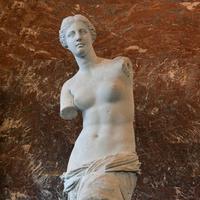More about Alexandros of Antioch
Works by Alexandros of Antioch

Contributor
Alexandros of Antioch may or may not have been tall, dark, or handsome, but this man of mystery certainly had talent
The only known work ever attributed to Alexandros is the Venus di Milo, and she might not even be one of his works! It’s confusing, but long story short, when the Venus de Milo was found by a farmer on the island of Milos, he thought she was just another crusty work of art and tossed her and her broken stand, which had the artist name inscribed on it, back into her hole. When Venus was taken to France by some French diplomats, her stand was left behind and continued to erode with the rolling times, making the inscription on it nearly impossible to read, so the artist’s name could either be Alexandros or Agasandros. Alexandros is catchier, though, so we’ll stick with that.
The only things really known about this artist, based on the style of Venus de Milo, is where Alexandros’ workshop was and when he worked. Thanks to Venus’s gently twisty curves, art historians can conclude that she was a work born in the Hellenistic period. During the Hellenistic period, people loved their sculptures of curvy naked ladies and they loved mythology because of the taboos attached to it. During the conquests of Alexander the Great, religion became something extremely personal and extremely divided. Essentially, no matter what religion you were, you were scandalous to somebody, and people always love a good scandal. To get away with proudly displaying an image of a goddess, artists began to employ a style called “naturalism,” which made their subjects look more realistic and relatable, no matter how mythical they were.
After Alexander the Great kicked the bucket, his lands became even more divided than they were during his life in more ways than just religion. His empire was split between his generals, who proved to not be the most adept of rulers, and the state of the nation began to decline. To keep spirits up art (more specifically Grecian art) began to play a major role in everyday life to unify and beautify the divided kingdoms. To meet the high demand of large Grecian statues and art, major workshops began to crop up across the empire, one of which was in Antioch. Even though the various workshops all tried to emulate the same Grecian style, they all developed their own flares. Venus’s flares most closely resemble those from Antioch, which leads historians to think that Alexandros worked in Antioch.
Alexandros worked in what was probably one of the most confusing times in ancient world history, and the confusion surrounding his identity is a pretty good indicator of that. Despite all that confusion, though, you have to give the guy credit for creating art that can stay relevant and fascinating beyond his time.
Featured Content
Here is what Wikipedia says about Alexandros of Antioch
Alexandros of Antioch (Greek: Ἀλέξανδρος) (2nd – 1st century BC) was a Greek sculptor of the Hellenistic age. He is thought to be the sculptor of the famous Venus de Milo statue.
Check out the full Wikipedia article about Alexandros of Antioch











